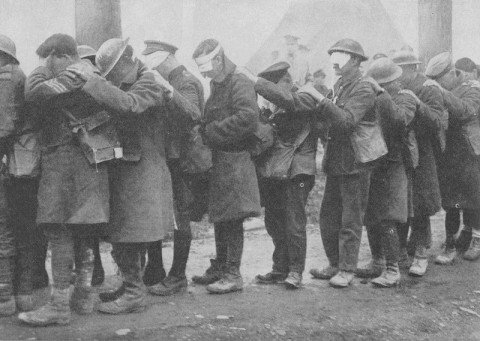FORETASTE OF THE FUTURE
Of all the forms of gas used in the Great War, that which had the least disastrous consequences was "tear gas." Its effect was to inflict temporary blindness on those who came in contact with it. This pathetic row of figures show men temporarily blinded in that way on the Western Front in April, 1918. Affecting as this scene is, the results of the deadly gases of today would be infinitely worse.
Another batch of photographs of 'Things of tomorrow'. After 'Death from the skies', 'The doom of cities', 'New horrors of air attack', and 'If war should come', there followed (and note the shift from the indefinite to the definite) Boyd Cable, 'When war does come: terrifying effects of gas attacks', in John Hammerton, ed., War in the Air: Aerial Wonders of our Time (London: Amalgamated Press, n.d. [1936]), 272-4.
Cable's theme this time is the extreme difficulty of defence against poison gas:
I confess that an examination of the methods officially recommended for protection against gas and for the decontamination and treatment of gas casualties is apt to create a depressing feeling of impotence and doubt as to the possibility of escape for more than a small fraction of the people.
These methods include the preparation of a gas-proof refuge in every home and the provision of gas masks for every individual. But can people live for hours on end confined in their gas refuges? Can small children be persuaded to wear gas masks? Moreover, gas masks will not guard against contact gases like mustard and lewisite, which require full-body protection; and 'There is no possibility and no intention of providing such an elaborate outfit for all non-combatants in this or any other densely populated country'.
Paint and wood absorb poison gas so thoroughly that there is no way to decontaminate them short of incineration: 'A badly gassed house would, therefore, require the destruction of doors, window frames, floors, stairs, and wooden furniture'. It might be possible to remove gas from wooden paving, concrete and stone if they were quickly hosed down, but whether this would be practicable with buildings broken and mains burst by high explosive is anyone's guess.
Cable stresses that he not being in the least bit imaginative in his description of the effects of gas, and refers readers to the Home Office's official handbooks or to the Red Cross for 'still more of the ghastly details'. And,
There is always a possibility or probability that new gases have been discovered and are being kept secret for use only when war does come, and that these may defeat our methods of protection and decontamination.
While he sceptical of ARP generally, Cable allows that is as well for families to be aware of the steps they can take to minimise the danger from gas; and the emergency workers who have been trained to control crowds of scared people may save many lives by leading them to safety.
But the greatest hope of the most practical results coming from all this teaching and drilling all over Europe, is that the people of every country are learning what gas attacks must mean to civilian non-combatants. The more thoroughly the people of each nation understand that War means Air War, and that Air War means inescapable and horrible death to hundreds of thousands, or to millions, the more we may hope that no nation will allow its rulers to lead or drag it into war.
GAS BOMBER GETS THROUGH
A scene such as that here depicted might easily occur if even one aeroplane got through the defences of a city and dropped a few gas bombs. Police and Red Cross men only are protected against the fumes, and the panic-stricken passengers from the omnibus have little chance of reaching a gas-proof shelter before they are overcome.
AT THE LAST GASP
This scene from Mr. Wells' film "Things to Come" is a forecast of the terrible possibilities of a future war. It shows what might happen in any great city after aerial raiders, dropping gas bombs, had passed over it. Men with steel helmets and gas masks are administering first aid to those caught in the deadly fumes of a gas bomb.
I get the feeling that War in the Air's pictures editor is starting to run out of ideas here. Affecting the photograph of the soldiers may be, but as the caption notes their blindness is temporary: hardly a portent of the collapse of civilisation. The passengers leaving the double-decker look to me no more hurried than they might be on any chilly night, certainly not 'panic-stricken'. And how much more free publicity does Things To Come need? Note what can't apparently be shown: an actual photograph of a gas victim scarred and burned by gas. Instead there are only mock air raids, drawings and film sets, and one image of soldiers with no visible wounds who will recover from their affliction. Flesh must be made to creep, but only so far.
![]() This work is licensed under a Creative Commons Attribution-NonCommercial-NoDerivatives 4.0 International License.
Permissions beyond the scope of this license may be available at http://airminded.org/copyright/.
This work is licensed under a Creative Commons Attribution-NonCommercial-NoDerivatives 4.0 International License.
Permissions beyond the scope of this license may be available at http://airminded.org/copyright/.



